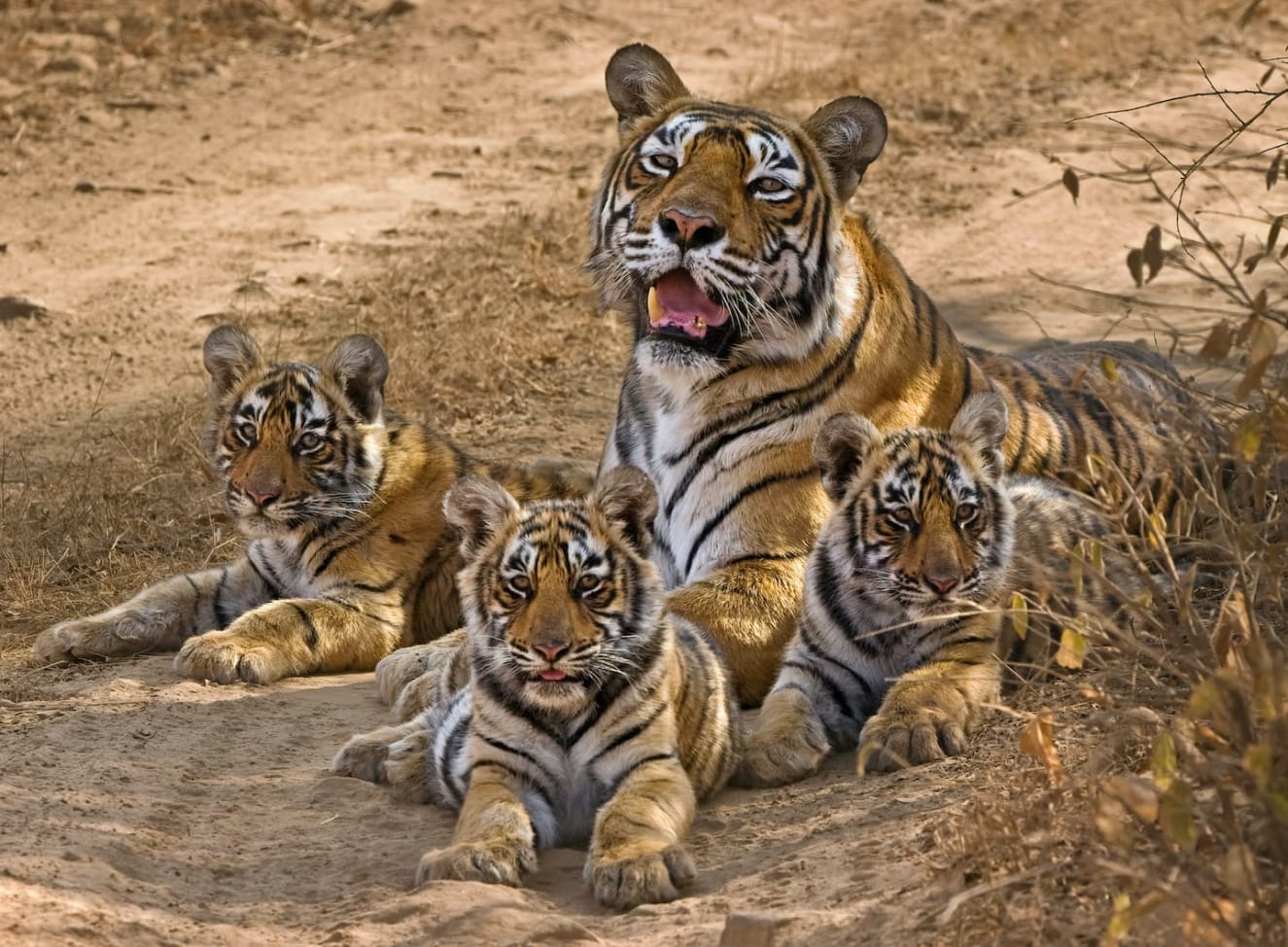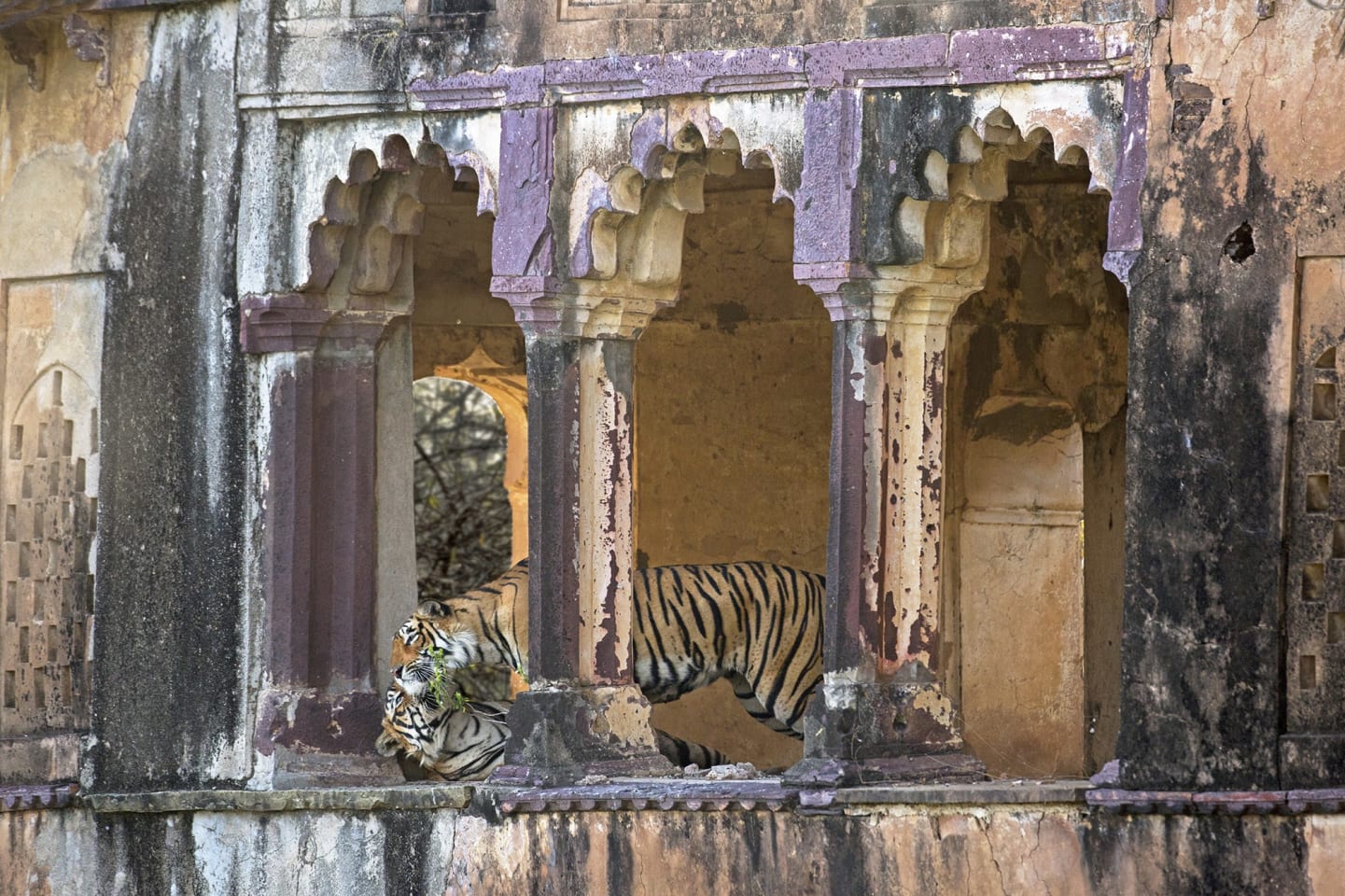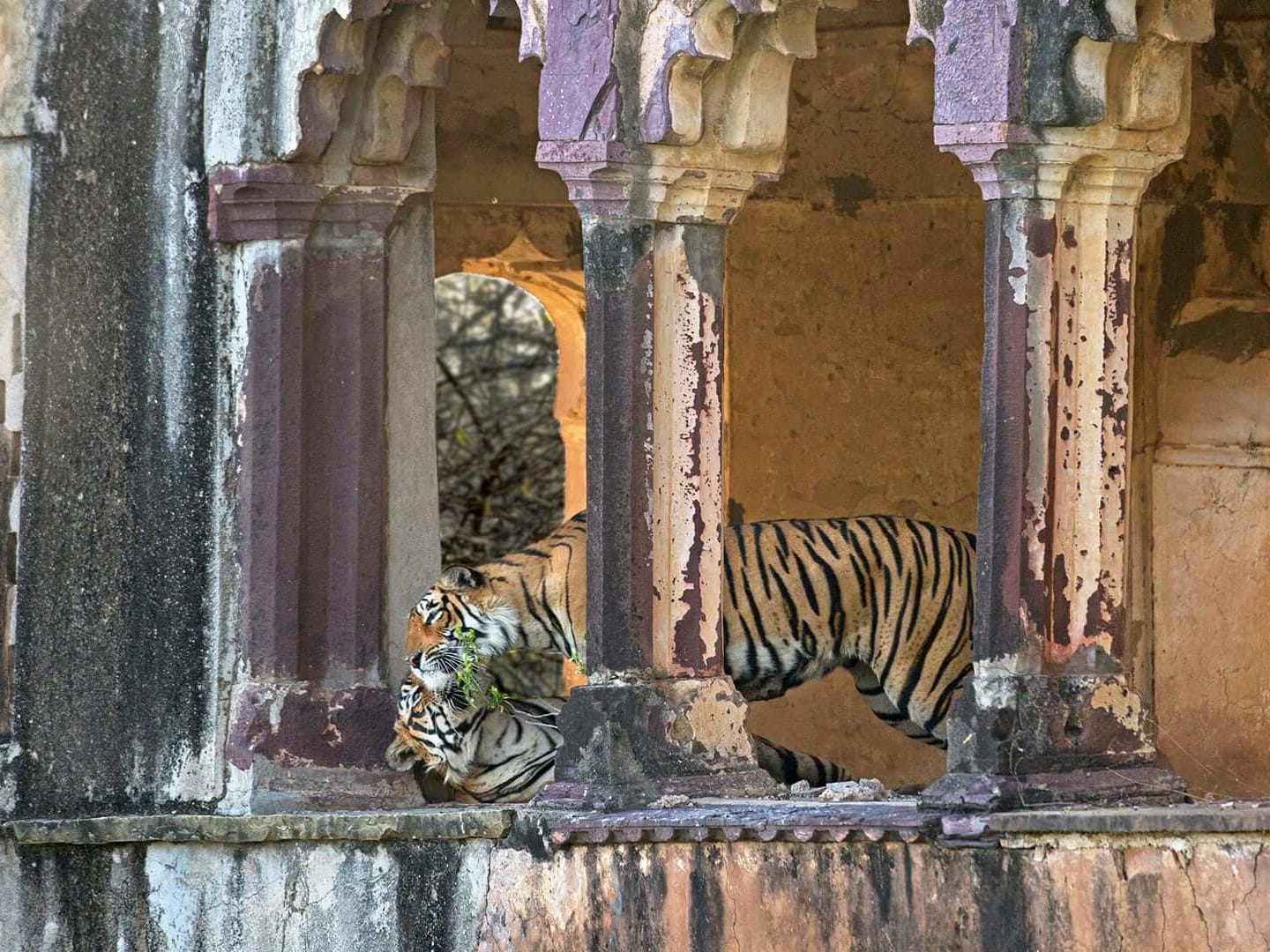 Listen to this article
•
15:34 min
Listen to this article
•
15:34 min
Out of India’s 600-odd protected areas, only 49 are tiger reserves. In spite of this, between 2014-15, these reserves hosted nearly one-third of all wildlife tourists. The opportunity to get a glimpse of the Bengal tiger in the wild is unrivalled. No one ever forgets their first glimpse of this big cat. As Valmik Thapar writes in his book, Tiger Fire — 500 Years of the Tiger in India, “….I saw my first tiger in Ranthambhore — from a floating jeep while I flashed the searchlight around. Framed in front of me and watching the commotion with its huge head above the wall was the tiger. I watched my first tiger for two minutes in hushed silence, and it was a sight I have never forgotten.” However, does this novelty wear out if you are a professional photographer, frequently visiting tiger reserves?
“No matter how many times you see a tiger, every time your heart skips a beat,” says Rathika Ramasamy, one of India’s leading wildlife photographers. Rathika has been photographing the tiger for 17 years, and yet every incident is special — a feeling that is echoed by her contemporaries. We reached out to some of India’s finest wildlife photographers and asked them to pick one unforgettable image of the tiger and their favourite memory of shooting the big cat.
ANISH ANDHERIA
Of the 102 islands that make up the Sundarbans mangrove forest, 54 are inhabited by humans while 48 are designated as the Sundarbans Tiger Reserve. The estuarine forest remains the epicentre of intense human-tiger conflict. On rare occasions, tigers that find hunting in its constantly-shifting tidal landscape difficult, wander into human settlements in search of prey, causing panic. Forest officials are usually contacted, who often amidst great drama and chaos rescue the tiger, and release it back into the wild.
In 2010, Anish Andheria was in the Sundarbans when a rescue operation was underway. The forest department had successfully captured a tiger that had wandered into a village. After ensuring the animal’s wellbeing, officials decided to release it. Tigers are usually left within the core of the tiger reserve, along one of Sunderbans’ many criss-crossing channels — it is safer to release them from a boat so that they cannot climb back or cause any harm to the people involved in the operation. The mission constitutes two forest department boats — one with the caged animal, and a handful of people responsible for the release, and another for assistance in case anything goes wrong with the main boat. Anish documented this moment from the accompanying boat.
“Romantically put, the body language of the tiger is that of exuberance as it leaps to freedom,” says Anish. This photo, framed with the Sundarbans’ landscape and its people, epitomises immense complexity of human-tiger interaction in the Sundarbans.
Dr. Anish Andheria is the President of the Wildlife Conservation Trust (WCT), a recipient of Carl Zeiss Conservation Award (2008), a conservationist and a wildlife photographer.

ADITYA “DICKY” SINGH
In 1998, Aditya “Dicky” Singh moved to the outskirts of Ranthambore National Park, and worked with numerous filmmakers and photographers who travelled to document the popular tigress Machali (T-16), fondly called the ‘Queen of Ranthambore’. Machali was a photographer’s dream — she rarely shied away from cameras, instead boldly used safari jeeps as cover while hunting for prey. With wildlife tourism, and digitisation of film and still photography on a rise, Machali soon became one of the most photographed tigers in the world.
Machali’s years at Ranthambore National Park were marked by great shifts, and much drama. From 2000-2004, Machali gave birth to three sets of litter. Around the same time, tiger numbers across India were dwindling. Poaching incidents were on a rise. “Machali in this dark period had managed to keep her litter alive despite being targeted a few times,” remembers Aditya. By 2006, Machali had aged and lost three of her four canines. She was rarely seen. Aditya and other officials at Ranthambore believed that this was the end of the road for her.
In the last few months of 2006, Aditya heard that Machali had given birth to another litter, though no one had confirmed the news. “On the afternoon of January 17, 2007, we were driving up Mandoop plateau when we heard some alarm calls. We waited for a few minutes, and then, Machali walked out of a gorge with three cubs in tow and sat down on the forest road ahead of us. I will probably never forget the next two hours. This picture will always be the thumbnail for that memory. This was Ranthambore’s tigers fighting back,” says Aditya. That day was remembered for many years to come. Not only had Machali given birth to a fourth litter at a time when tiger numbers were falling, but her offspring went on to become stars in their own right.
Aditya “Dicky” Singh is a wildlife photographer, who lives and works on the outskirts of Ranthambore National Park.
PALLAVI LAVETI
Pallavi Laveti’s first visit to Ranthambore National Park was on a hot summer day, when she was introduced to Krishna (T-19), Machali’s daughter. Krishna has given Ranthambore the most number of litters till date. In this photo, she is with one of her sub-adults from the third litter.
As visitor vehicles surrounded Krishna, she continued to cool herself in a waterhole. She let out a gentle roar calling out to her young ones, and soon two appeared from the thicket. While one walked towards the water for a swig, the other obediently moved towards the mother. A two-hour-long display of affection unfolded between the mother and her cubs. “The look of pure contentment on the cub’s face left me thinking that every relationship among every species is unique. But there is one that transcends all — the bond between a mother and her offspring. After all, there is a little bit of us in them and a little bit of them in us,” shares Pallavi.
Pallavi Laveti is an HR professional turned wildlife photographer who photographs everything — from reptiles to mammals — in wildernesses and urban jungles.

SACHIN RAI
On one of his tours in Ranthambore National Park, Sachin Rai was informed about a courting pair spotted in the park’s Zone 3. After driving through the arid landscape, he spotted Arrowhead (T-84), Krishna’s daughter approaching a sleepy male (T-91) in the Mughal ruins of the Hunting Palace — ironically the place where kings once hunted the big cat from.
Arrowhead, the dominant tigress in the area then, gently pursued the young male. The pair mated once at the palace and again by the lakebed. “What’s interesting is that she had her first litter close to a year after this photo was taken,” says Sachin. In the span of one year, Arrowhead had apparently mated with three different males before finally having her first litter with the one (T-86) who stayed in that area in Ranthambore. “Perhaps this directs us to the theory of mock-mating that the big cats engage in.”
Sachin Rai is a professional nature photographer, a photography mentor and conducts photography tours across the world.
SHIVANG MEHTA
“Let’s do one last round of the lake as we still have 20 minutes left,” Shivang Mehta told his guide, Shakir, on a dull morning as he was looking for the tigress. Krishna. In a matter of minutes, the forest guard informed them that the tigress had been spotted by the lake. Surrounded by multiple vehicles, Shivang decided to stay away when Shakir exclaimed “tiger”!
Krishna’s sub-adult son, Pacman (T-85) had fiercely attacked a spotted deer fawn right behind Shivang’s vehicle. “Tigers usually choke their prey by grabbing their neck,” says Shivang, but “here was an inexperienced cub who had made a mess of his first kill.” Pacman had grabbed the fawn by its back and refused to give up. He then dragged his catch away to a forest clearing, where he tried to choke its neck. As the tussle continued, Pacman’s sister, Arrowhead watched his attempts silently. With increasing pressure on Pacman, he finally tore the hind of his catch, who finally breathed its last. Pacman emerged victorious, smeared with blood, while his sister walked towards him to share his first kill.
Shivang Mehta is a wildlife photographer, co-founder of Nature Wanderers, Canon India brand ambassador and has authored three books: A Decade with Tigers, Chasing Horizons and Leopards and Shepherds of Jawai (co-author).
RATHIKA RAMASAMY
It was turning out to be an unsuccessful fourth consecutive day for Rathika Ramasamy on her visit to Jim Corbett National Park. As the park’s closing time approached, she began making her way to the exit, when, suddenly on the dry riverbed, she saw a tiger emerging from the bushes. This sub-adult was Sharmilee’s daughter. On the other end, a herd of spotted deer was grazing. While the deer froze, the tigress remained oblivious. “I was waiting for the tigress to turn and look at the deer,” recalls Rathika. And she did.
In a fleeting second, the predator and prey made eye contact — just enough to allow Rathika to capture this rare moment. Then the tigress continued to walk away. “Animals do not attack prey unless they need to eat, we humans keep acquiring things, whether or not we require them,” says Rathika.
Rathika Ramasamy is a wildlife photographer, masterclass mentor and conducts photography workshops.
JAGDEEP RAJPUT
Charger was among the most feared tigers in Bandhavgarh National Park, named so because he charged at vehicles and elephants with tourists. It is believed that in his prime, Charger was so aggressive that he sent people scampering away in the opposite direction. “Once he happened to charge at jeeps and people hid their kids under the seats of their cars,” shares Jagdeep Rajput.
On this day, Jagdeep, perched on an elephant, maintained safe distance from Charger, as the fierce tiger sat by a waterhole. Suddenly, the elephant decided to pluck grass around the waterbody — infuriating Charger. He aggressively snarled at the elephant and Jagdeep used this opportunity to capture ten frames on his film camera. Only this photo turned out to be in focus. “This picture truly displays the spirit of Charger,” says Jagdeep.
Jagdeep Rajput is an internationally acclaimed wildlife photographer, editor at Nature Photographers Network (NPN), USA and Canon EOS Ambassador.
SOUMYAJIT NANDY
Soumyajit Nandy started photographing tigers in Sundarbans in December 2014. “In the mangrove forests, tiger sightings are rare and usually when it happens, it happens from a distance.” But on one beautiful December morning, when Soumyajit was out on one of his tours, he spotted a dominant male tiger. Few of his excited visitors wanted to catch a closer glimpse of the tiger. But having studied the behaviour of tigers in the Sundarbans, Soumyajit knew that this would cause the tiger to rush back into the mangrove forest. “I requested the boatman to maintain a distance. Let the tiger get comfortable with our presence,” he said.
In a few hours, the magic unfolded.
Soumyajit and his group were able to follow the tiger for the next 5-6 hours. He photographed various behavioural patterns of the tiger — sniffing trees, scent marking, jumping across dry narrow creeks and many other territorial characteristics. “This image is special because I think it sums up the magic of human-animal interaction when boundaries are respected.”
Soumyajit Nandy is a wildlife photographer documenting tigers of the Indian Sundarbans.














